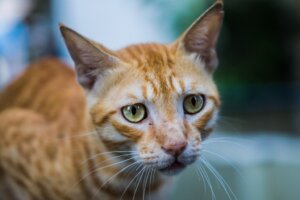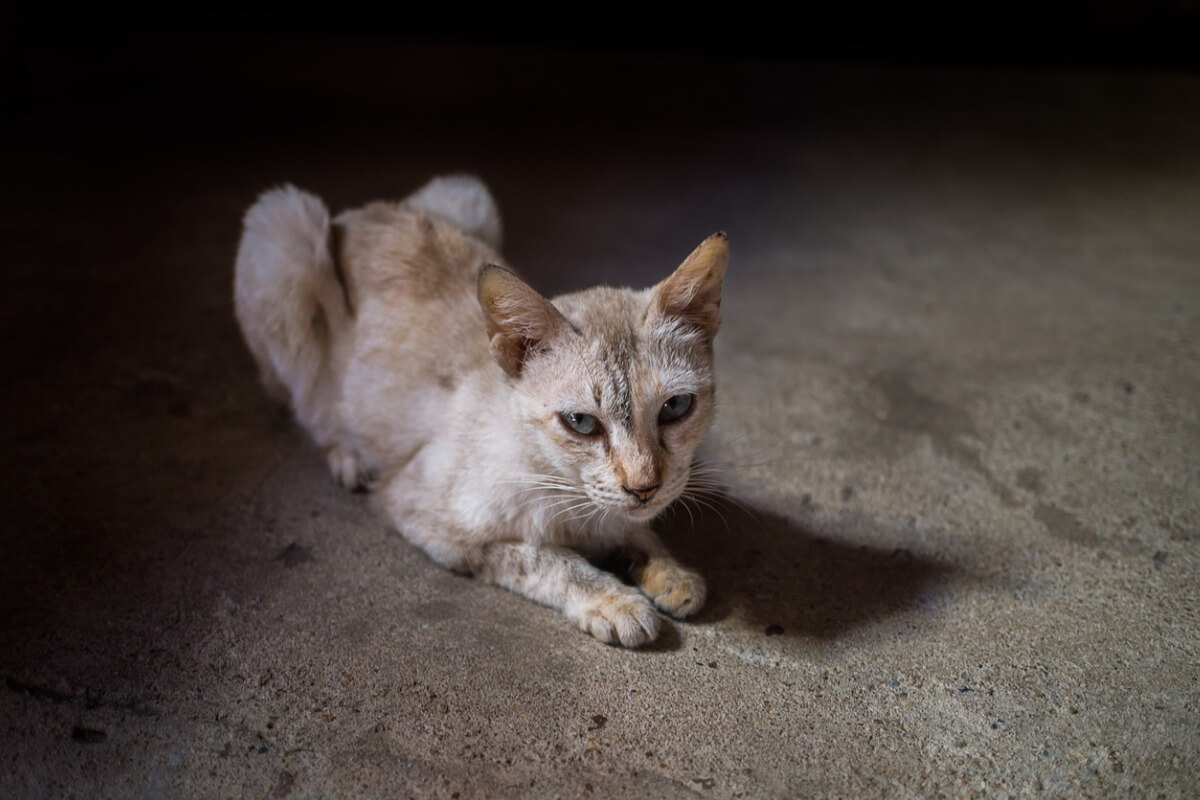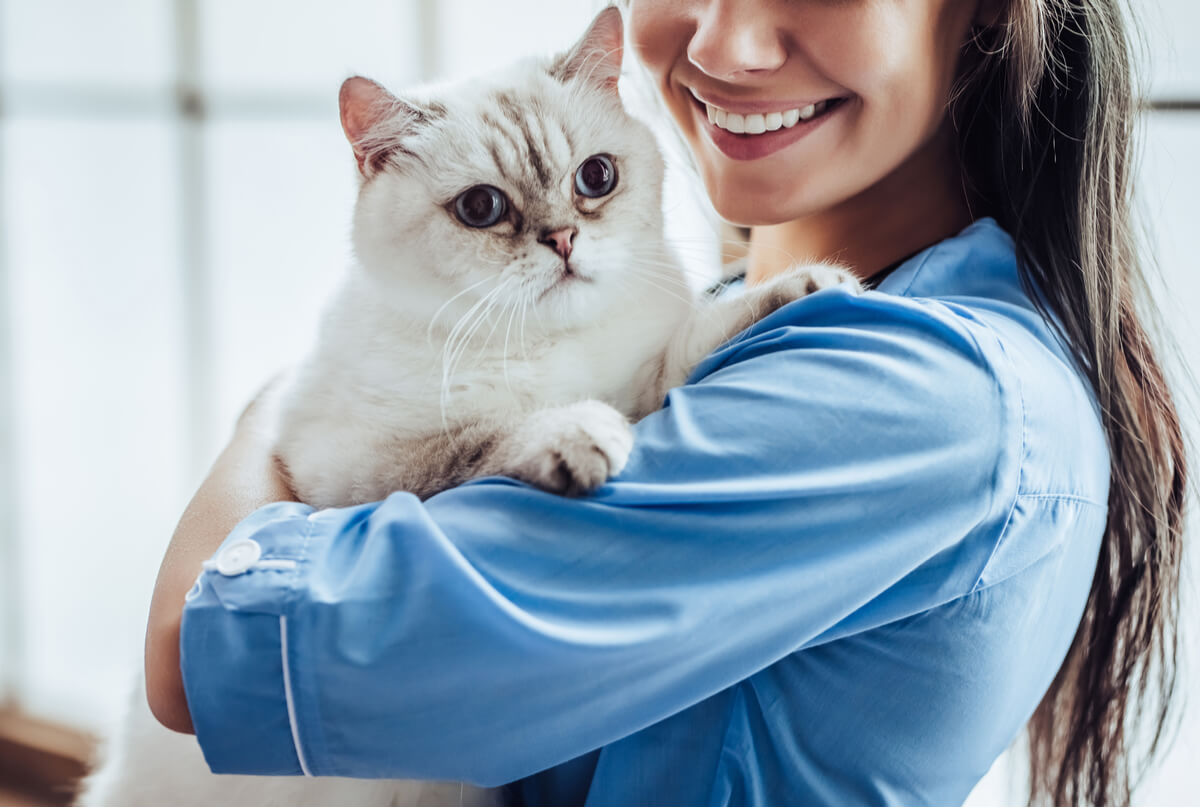Anorexia in Cats: Everything You Need to Know


Reviewed and approved by the biologist Samuel Sanchez
Incredible as it may seem to owners, anorexia in cats exists and is a sign of illness that must be treated immediately. Even veterinary experts agree that it’s one of the most frequent illnesses in cats, and it has its origin in many different conditions.
It must be remembered that cats are neophobic animals, which means that they have a phobia of anything new. Being lovers of routine, they can get stressed when something strange and different happens around them. So, things as simple for humans as changing the feed or the sand, changing the floor, and the arrival of a baby at home can trigger anorexia.
Due to the high prevalence of this condition, in this article, we’re going to tell you everything you need to know about it. We’ll be looking at what is anorexia in cats, how it can affect their bodies, the symptoms, the causes, and the possible treatment that’s available.
What is anorexia in cats?
Anorexia is described in scientific articles as an eating disorder in which the person or animal stops eating. In the case of cats, anorexia is diagnosed when they stop eating or have a significant and persistent loss of appetite.
Experts from the National University of Mexico (UNAM) explain that cats don’t develop anorexia overnight, but begin to stop eating little by little until they no longer eat anything. They urge owners to be attentive to this type of behavior and attend to it if they think something is wrong – they must do this before it’s too late.
95% of the conditions that a sick cat has are related to anorexia to some degree.

The development of anorexia in cats
Feline anorexia can trigger Feline Idiopathic Hepatic Lipidosis. According to research, this is one of the most common liver disorders in cats, the result of the excessive hepatocellular accumulation of triacylglycerides.
It’s one of the most frequent causes of death in domestic cats, because their body requires constant feeding and this condition prevents it. In addition to anorexia, stress and obesity are factors associated with this disease that must be taken into account.
Types of anorexia in cats
Feline anorexia itself refers to the voluntary loss of appetite, that is, the cat consciously stops feeding, but could still physically continue to do so. However, this isn’t the only reason why a feline stops eating. There are, in fact, different types of anorexia in cats, among which we can highlight the following:
- Pseudoanorexia: This happens when the cat does want to eat, but the food that’s provided or something in its body causes pain or discomfort when swallowing. So, given the discomfort that it produces, it prefers to stop eating.
- Psychological anorexia: This is when the cat stops eating because the act itself is related to some physical or psychological trauma.
Symptoms of anorexia in cats
Feline anorexia is classified as a sign of disease and not as a disease in itself. For owners, it’s important to identify the symptoms that warn of its presence, as the anorexic cat must be treated in time to avoid the development of associated diseases. Pay special attention if you notice any of the following:
- Weight loss
- Muscle atrophy or loss of muscle mass
- Weakness and fatigue
- Hair loss or poor quality
However, the animal may have other symptoms associated with the underlying disease that produces anorexia, such as the following:
- Vomiting, regurgitation, hypersalivation, cough, fever, and an extended head and neck posture when swallowing – this is when esophageal and gastric disorders are present.
- Diarrhea, vomiting, and dehydration when there’s inflammatory bowel disease.
- Abdominal pain, dehydration, and weakness – signs that warn of possible pancreatitis.
- Jaundice or a yellow color in mucous membranes, lethargy, and a distended abdomen – this is when there’s a hepatobiliary disease.
- Excessive urination and water intake due to kidney disease.
Causes
The causes of feline anorexia are many, and can occur without distinction of breed or age, despite the fact that there’s a higher prevalence in older cats. This is because the wear and tear of their body associated with the passage of time means that they can develop different diseases that are related to a lack of appetite.
Here are the most common causes of anorexia in cats:
- Oral discomfort: Infections or any type of disease that affects the gums, teeth, or soft tissues of the mouth can lead to the cat developing anorexia.
- Feed conditions: The change of feed, or the texture or smell of food can cause the cat to stop consuming the food. Check that it isn’t too hard and try to offer more palatable foods.
- Heat: When a cat goes into heat they become anxious and may put food aside to focus on reproduction. Spaying is a way to avoid stress and anxiety for felines during this stage.
- Stress: Cats are neophobic, so any alteration in their routine or life dynamics can lead to stress and anxiety, in turn leading to anorexia.
- Infections or parasites: Any type of infection or discomfort due to intestinal or extra-intestinal parasites can cause the cat to stop eating, as these diseases weaken it.
- Esophageal disease: Here there’s reflux or the presence of foreign bodies that cause discomfort and pain to the cat when swallowing.
- Kidney failure, bowel disease, liver or biliary disease, and pancreatic disease – all of these conditions cause internal pain and discomfort.
Diagnosis
When the owner is able to closely monitor their cat’s behaviors, it’s much easier to diagnose anorexia. The main reason for concern is the lack of appetite, so whenever you notice that the cat is eating little or not eating at all, the veterinarian should be consulted.
The vet will try by all means to establish the origin of this lack of appetite. To do this, they may perform physical examinations, blood tests, X-rays, ultrasounds, cytologies, and biopsies. In addition, they’ll prepare a report or anamnesis with the data provided by the caregiver and those collected through the aforementioned techniques.
Anorexia is a nonspecific symptom realted to many different diseases. Because of this, many different tests must be performed on the cat.
Treatment
The treatment of anorexia in cats will depend, to a great extent, on the illness that’s causing it. Whatever the case, the faster the care and implementation of the treatment, the faster the recovery. When the cat isn’t feeling so bad and the reason for the loss of appetite is identified, the treatment will lead to a prompt improvement and the recovery of their appetite.
In more complex cases, treatment may include intravenous hydration and even nasogastric tube-assisted feeding, which runs from the nose to the stomach. An esophagostomy tube may also be chosen, which runs from the esophagus to the stomach through an incision in the neck.
Research indicates that a high percentage of hospitalized cats suffer from anorexia, a condition that can be aggravated due to the stress produced by having to be in hospital. Treatment always consists of controlling pain and providing adequate nutrition to the cat, which can be given through the aforementioned tubes.

Prognosis of anorexia in cats
Anorexia in cats, as well as the underlying diseases that produce it has a better prognosis if it’s diagnosed early. Regardless of the type of anorexia, the cat will be able to recover much easier if it receives prompt treatment. Don’t regard your cat’s lack of appetite as something normal, and go and see the vet as soon as possible.
Incredible as it may seem to owners, anorexia in cats exists and is a sign of illness that must be treated immediately. Even veterinary experts agree that it’s one of the most frequent illnesses in cats, and it has its origin in many different conditions.
It must be remembered that cats are neophobic animals, which means that they have a phobia of anything new. Being lovers of routine, they can get stressed when something strange and different happens around them. So, things as simple for humans as changing the feed or the sand, changing the floor, and the arrival of a baby at home can trigger anorexia.
Due to the high prevalence of this condition, in this article, we’re going to tell you everything you need to know about it. We’ll be looking at what is anorexia in cats, how it can affect their bodies, the symptoms, the causes, and the possible treatment that’s available.
What is anorexia in cats?
Anorexia is described in scientific articles as an eating disorder in which the person or animal stops eating. In the case of cats, anorexia is diagnosed when they stop eating or have a significant and persistent loss of appetite.
Experts from the National University of Mexico (UNAM) explain that cats don’t develop anorexia overnight, but begin to stop eating little by little until they no longer eat anything. They urge owners to be attentive to this type of behavior and attend to it if they think something is wrong – they must do this before it’s too late.
95% of the conditions that a sick cat has are related to anorexia to some degree.

The development of anorexia in cats
Feline anorexia can trigger Feline Idiopathic Hepatic Lipidosis. According to research, this is one of the most common liver disorders in cats, the result of the excessive hepatocellular accumulation of triacylglycerides.
It’s one of the most frequent causes of death in domestic cats, because their body requires constant feeding and this condition prevents it. In addition to anorexia, stress and obesity are factors associated with this disease that must be taken into account.
Types of anorexia in cats
Feline anorexia itself refers to the voluntary loss of appetite, that is, the cat consciously stops feeding, but could still physically continue to do so. However, this isn’t the only reason why a feline stops eating. There are, in fact, different types of anorexia in cats, among which we can highlight the following:
- Pseudoanorexia: This happens when the cat does want to eat, but the food that’s provided or something in its body causes pain or discomfort when swallowing. So, given the discomfort that it produces, it prefers to stop eating.
- Psychological anorexia: This is when the cat stops eating because the act itself is related to some physical or psychological trauma.
Symptoms of anorexia in cats
Feline anorexia is classified as a sign of disease and not as a disease in itself. For owners, it’s important to identify the symptoms that warn of its presence, as the anorexic cat must be treated in time to avoid the development of associated diseases. Pay special attention if you notice any of the following:
- Weight loss
- Muscle atrophy or loss of muscle mass
- Weakness and fatigue
- Hair loss or poor quality
However, the animal may have other symptoms associated with the underlying disease that produces anorexia, such as the following:
- Vomiting, regurgitation, hypersalivation, cough, fever, and an extended head and neck posture when swallowing – this is when esophageal and gastric disorders are present.
- Diarrhea, vomiting, and dehydration when there’s inflammatory bowel disease.
- Abdominal pain, dehydration, and weakness – signs that warn of possible pancreatitis.
- Jaundice or a yellow color in mucous membranes, lethargy, and a distended abdomen – this is when there’s a hepatobiliary disease.
- Excessive urination and water intake due to kidney disease.
Causes
The causes of feline anorexia are many, and can occur without distinction of breed or age, despite the fact that there’s a higher prevalence in older cats. This is because the wear and tear of their body associated with the passage of time means that they can develop different diseases that are related to a lack of appetite.
Here are the most common causes of anorexia in cats:
- Oral discomfort: Infections or any type of disease that affects the gums, teeth, or soft tissues of the mouth can lead to the cat developing anorexia.
- Feed conditions: The change of feed, or the texture or smell of food can cause the cat to stop consuming the food. Check that it isn’t too hard and try to offer more palatable foods.
- Heat: When a cat goes into heat they become anxious and may put food aside to focus on reproduction. Spaying is a way to avoid stress and anxiety for felines during this stage.
- Stress: Cats are neophobic, so any alteration in their routine or life dynamics can lead to stress and anxiety, in turn leading to anorexia.
- Infections or parasites: Any type of infection or discomfort due to intestinal or extra-intestinal parasites can cause the cat to stop eating, as these diseases weaken it.
- Esophageal disease: Here there’s reflux or the presence of foreign bodies that cause discomfort and pain to the cat when swallowing.
- Kidney failure, bowel disease, liver or biliary disease, and pancreatic disease – all of these conditions cause internal pain and discomfort.
Diagnosis
When the owner is able to closely monitor their cat’s behaviors, it’s much easier to diagnose anorexia. The main reason for concern is the lack of appetite, so whenever you notice that the cat is eating little or not eating at all, the veterinarian should be consulted.
The vet will try by all means to establish the origin of this lack of appetite. To do this, they may perform physical examinations, blood tests, X-rays, ultrasounds, cytologies, and biopsies. In addition, they’ll prepare a report or anamnesis with the data provided by the caregiver and those collected through the aforementioned techniques.
Anorexia is a nonspecific symptom realted to many different diseases. Because of this, many different tests must be performed on the cat.
Treatment
The treatment of anorexia in cats will depend, to a great extent, on the illness that’s causing it. Whatever the case, the faster the care and implementation of the treatment, the faster the recovery. When the cat isn’t feeling so bad and the reason for the loss of appetite is identified, the treatment will lead to a prompt improvement and the recovery of their appetite.
In more complex cases, treatment may include intravenous hydration and even nasogastric tube-assisted feeding, which runs from the nose to the stomach. An esophagostomy tube may also be chosen, which runs from the esophagus to the stomach through an incision in the neck.
Research indicates that a high percentage of hospitalized cats suffer from anorexia, a condition that can be aggravated due to the stress produced by having to be in hospital. Treatment always consists of controlling pain and providing adequate nutrition to the cat, which can be given through the aforementioned tubes.

Prognosis of anorexia in cats
Anorexia in cats, as well as the underlying diseases that produce it has a better prognosis if it’s diagnosed early. Regardless of the type of anorexia, the cat will be able to recover much easier if it receives prompt treatment. Don’t regard your cat’s lack of appetite as something normal, and go and see the vet as soon as possible.
All cited sources were thoroughly reviewed by our team to ensure their quality, reliability, currency, and validity. The bibliography of this article was considered reliable and of academic or scientific accuracy.
- Gasca, A. Guía para el diagnóstico, manejo clínico y terapéutico de pacientes con Lipidosis Hepática Idiopática Felina. Corporación Universitaria Lasallista. 2020.
- La anorexia en gatos, síntoma frecuente de enfermedad. Boletín Universidad Nacional de México (UNAM). 2018.
- Fuertes, J., Pérez, R., Hernández, A. Trastornos de la conducta alimentaria. Anorexia y bulimia. Offarm. Vol. 29, 2010.
- Manejo de la anorexia en el gato hospitalizado. Nutrición enteral por sonda nasoesofágica. Gattos centro Clínico Felino.
This text is provided for informational purposes only and does not replace consultation with a professional. If in doubt, consult your specialist.








